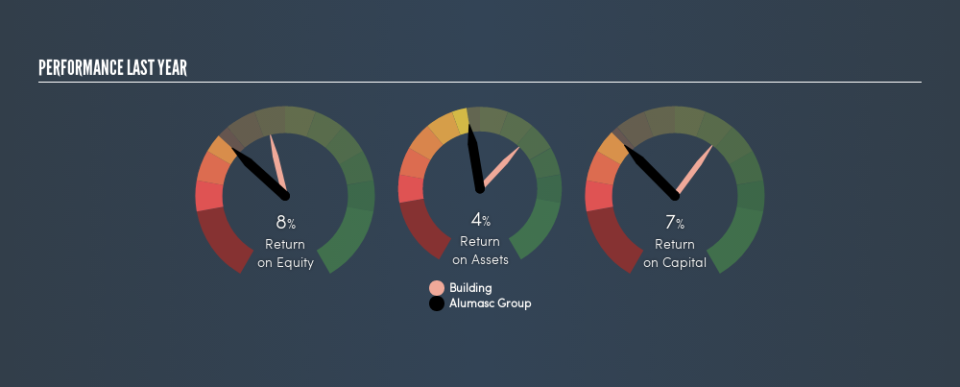The Alumasc Group plc (LON:ALU) Might Not Be A Great Investment

Want to participate in a short research study? Help shape the future of investing tools and receive a $20 prize!
Today we are going to look at The Alumasc Group plc (LON:ALU) to see whether it might be an attractive investment prospect. Specifically, we’re going to calculate its Return On Capital Employed (ROCE), in the hopes of getting some insight into the business.
First of all, we’ll work out how to calculate ROCE. Second, we’ll look at its ROCE compared to similar companies. And finally, we’ll look at how its current liabilities are impacting its ROCE.
Understanding Return On Capital Employed (ROCE)
ROCE is a measure of a company’s yearly pre-tax profit (its return), relative to the capital employed in the business. Generally speaking a higher ROCE is better. In brief, it is a useful tool, but it is not without drawbacks. Renowned investment researcher Michael Mauboussin has suggested that a high ROCE can indicate that ‘one dollar invested in the company generates value of more than one dollar’.
So, How Do We Calculate ROCE?
The formula for calculating the return on capital employed is:
Return on Capital Employed = Earnings Before Interest and Tax (EBIT) ÷ (Total Assets – Current Liabilities)
Or for Alumasc Group:
0.066 = UK£5.6m ÷ (UK£67m – UK£18m) (Based on the trailing twelve months to December 2018.)
So, Alumasc Group has an ROCE of 6.6%.
See our latest analysis for Alumasc Group
Does Alumasc Group Have A Good ROCE?
One way to assess ROCE is to compare similar companies. We can see Alumasc Group’s ROCE is meaningfully below the Building industry average of 11%. This performance is not ideal, as it suggests the company may not be deploying its capital as effectively as some competitors. Separate from how Alumasc Group stacks up against its industry, its ROCE in absolute terms is mediocre; relative to the returns on government bonds. Readers may find more attractive investment prospects elsewhere.
As we can see, Alumasc Group currently has an ROCE of 6.6%, less than the 16% it reported 3 years ago. So investors might consider if it has had issues recently.
It is important to remember that ROCE shows past performance, and is not necessarily predictive. ROCE can be misleading for companies in cyclical industries, with returns looking impressive during the boom times, but very weak during the busts. ROCE is, after all, simply a snap shot of a single year. What happens in the future is pretty important for investors, so we have prepared a free report on analyst forecasts for Alumasc Group.
Do Alumasc Group’s Current Liabilities Skew Its ROCE?
Current liabilities are short term bills and invoices that need to be paid in 12 months or less. Due to the way the ROCE equation works, having large bills due in the near term can make it look as though a company has less capital employed, and thus a higher ROCE than usual. To counter this, investors can check if a company has high current liabilities relative to total assets.
Alumasc Group has total liabilities of UK£18m and total assets of UK£67m. As a result, its current liabilities are equal to approximately 27% of its total assets. This very reasonable level of current liabilities would not boost the ROCE by much.
The Bottom Line On Alumasc Group’s ROCE
With that in mind, we’re not overly impressed with Alumasc Group’s ROCE, so it may not be the most appealing prospect. You might be able to find a better buy than Alumasc Group. If you want a selection of possible winners, check out this free list of interesting companies that trade on a P/E below 20 (but have proven they can grow earnings).
If you like to buy stocks alongside management, then you might just love this free list of companies. (Hint: insiders have been buying them).
We aim to bring you long-term focused research analysis driven by fundamental data. Note that our analysis may not factor in the latest price-sensitive company announcements or qualitative material.
If you spot an error that warrants correction, please contact the editor at editorial-team@simplywallst.com. This article by Simply Wall St is general in nature. It does not constitute a recommendation to buy or sell any stock, and does not take account of your objectives, or your financial situation. Simply Wall St has no position in the stocks mentioned. Thank you for reading.


